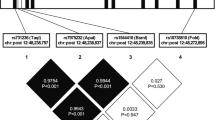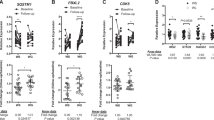Abstract
Background:
Black women have lower visceral adipose tissue (VAT) but are less insulin sensitive than white women; the mechanisms responsible are unknown.
Objective:
The study aimed to test the hypothesis that variation in subcutaneous adipose tissue (SAT) sensitivity to glucocorticoids might underlie these differences.
Methods:
Body fatness (dual energy X-ray absorptiometry) and distribution (computerized tomography), insulin sensitivity (SI, intravenous and oral glucose tolerance tests), and expression of 11β-hydroxysteroid dehydrogenase-1 (11HSD1), hexose-6-phosphate dehydrogenase and glucocorticoid receptor-α (GRα), as well as genes involved in adipogenesis and inflammation were measured in abdominal deep SAT, superficial SAT and gluteal SAT (GLUT) depots of 56 normal-weight or obese black and white premenopausal South African (SA) women. We used a combination of univariate and multivariate statistics to evaluate ethnic-specific patterns in adipose gene expression and related body composition and insulin sensitivity measures.
Results:
Although 11HSD1 activity and mRNA did not differ by ethnicity, GRα mRNA levels were significantly lower in SAT of black compared with white women, particularly in the GLUT depot (0.52±0.21 vs 0.91±0.26 AU, respectively, P<0.01). In black women, lower SAT GRα mRNA levels were associated with increased inflammatory gene transcript levels and abdominal SAT area, and reduced adipogenic gene transcript levels, VAT/SAT ratio and SI. Abdominal SAT 11HSD1 activity associated with increased VAT area and decreased SI in white, but not in black women.
Conclusions:
In black SA women, downregulation of GRα mRNA levels with obesity and reduced insulin sensitivity, possibly via increased SAT inflammation, is associated with reduced VAT accumulation.
This is a preview of subscription content, access via your institution
Access options
Subscribe to this journal
Receive 12 print issues and online access
$259.00 per year
only $21.58 per issue
Buy this article
- Purchase on Springer Link
- Instant access to full article PDF
Prices may be subject to local taxes which are calculated during checkout





Similar content being viewed by others
References
Goedecke JH, Dave JA, Faulenbach MV, Utzschneider KM, Lambert EV, West S et al. Insulin response in relation to insulin sensitivity: an appropriate beta-cell response in black South African women. Diabetes Care 2009; 32: 860–865.
van der Merwe MT, Crowther NJ, Schlaphoff GP, Gray IP, Joffe BI, Lönnroth PN . Evidence for insulin resistance in black women from South Africa. Int J Obes Relat Metab Disord 2000; 24: 1340–1346.
Lovejoy JC, la Bretonne de JA, Tulley R . Abdominal fat distribution and metabolic risk factors: effects of race. Metab Clin Exp 1996; 45: 1119–1124.
Després JP . Abdominal obesity as important component of insulin-resistance syndrome. Nutrition 1993; 9: 452–459.
Preis SR, Massaro JM, Robins SJ, Hoffmann U, Vasan RS, Irlbeck T et al. Abdominal subcutaneous and visceral adipose tissue and insulin resistance in the framingham heart study. Obesity 2009; 18: 2191–2198.
Manolopoulos KN, Karpe F, Frayn KN . Gluteofemoral body fat as a determinant of metabolic health. Int J Obes Relat Metab Disord 2010; 34: 949–959.
Rush EC, Goedecke JH, Jennings C, Micklesfield L, Dugas L, Lambert EV et al. BMI, fat and muscle differences in urban women of five ethnicities from two countries. Int J Obes Relat Metab Disord 2007; 31: 1232–1239.
Evans J, Goedecke JH, Söderström I, Burén J, Alvehus M, Blomquist C et al. Depot- and ethnic-specific differences in the relationship between adipose tissue inflammation and insulin sensitivity. Clin Endocrinol 2010; 74: 51–59.
Boscaro M, Barzon L, Fallo F, Sonino N . Cushing's syndrome. Lancet 2001; 357: 783–791.
Busillo JM, Cidlowski JA . The five Rs of glucocorticoid action during inflammation: ready, reinforce, repress, resolve, and restore. Trends Endocrinol Metab 2013; 24: 109–119.
Tomlinson JW . 11-Hydroxysteroid dehydrogenase type 1: a tissue-specific regulator of glucocorticoid response. End Rev 2004; 25: 831–866.
Atanasov AG, Nashev LG, Schweizer RAS, Frick C, Odermatt A . Hexose-6-phosphate dehydrogenase determines the reaction direction of 11β-hydroxysteroid dehydrogenase type 1 as an oxoreductase. FEBS Lett 2004; 571: 129–133.
Staab CA, Maser E . 11β-Hydroxysteroid dehydrogenase type 1 is an important regulator at the interface of obesity and inflammation. J Steroid Biochem Mol Biol 2010; 119: 56–72.
Sai S, Esteves CL, Kelly V, Michailidou Z, Anderson K, Coll AP et al. Glucocorticoid regulation of the promoter of 11 -hydroxysteroid dehydrogenase type 1 is indirect and requires CCAAT/enhancer-binding protein. Mol Endocrinol 2008; 22: 2049–2060.
Goedecke JH, Wake DJ, Levitt NS, Lambert EV, Collins MR, Morton NM et al. Glucocorticoid metabolism within superficial subcutaneous rather than visceral adipose tissue is associated with features of the metabolic syndrome in South African women. Clin Endocrinol 2006; 65: 81–87.
Wake DJ, Walker B . 11β-Hydroxysteroid dehydrogenase type 1 in obesity and the metabolic syndrome. Mol Cel Endocrinol 2004; 215: 45–54.
Rask E, Walker BR, Derberg SS, Livingstone DEW, Eliasson M, Johnson O et al. Tissue-specific changes in peripheral cortisol metabolism in obese women: increased adipose 11hydroxysteroid dehydrogenase type 1 activity. J Clin Endocrinol Metab 2002; 87: 3330–3336.
Kannisto K, Pietiläinen KH, Ehrenborg E, Rissanen A, Kaprio J, Hamsten A et al. Overexpression of 11beta-hydroxysteroid dehydrogenase-1 in adipose tissue is associated with acquired obesity and features of insulin resistance: studies in young adult monozygotic twins. J Clin Endocrinol Metab 2004; 89: 4414–4421.
Tomlinson JW, Moore J, Cooper MS, Bujalska I, Shahmanesh M, Burt C et al. Regulation of expression of 11beta-hydroxysteroid dehydrogenase type 1 in adipose tissue: tissue-specific induction by cytokines. Endocrinology 2001; 142: 1982–1989.
Nixon M, Wake DJ, Livingstone DE, Stimson RH, Esteves CL, Seckl JR et al. Salicylate downregulates 11 -HSD1 expression in adipose tissue in obese mice and in humans, mediating insulin sensitization. Diabetes 2012; 61: 790–796.
Wake DJ, Rask E, Livingstone DE, Soderberg S, Olsson T, Walker BR . Local and systemic impact of transcriptional up-regulation of 11β-hydroxysteroid dehydrogenase type 1 in adipose tissue in human obesity. J Clin Endocrinol Metab 2003; 88: 3983–3988.
Boullu-Ciocca S, Paulmyer-Lacroix O, Fina F, Ouafik L, Alessi M-C, Oliver C et al. Expression of the mRNAs coding for the glucocorticoid receptor isoforms in obesity. Obes Res 2003; 11: 925–929.
Michailidou Z, Jensen MD, Dumesic DA, Chapman KE, Seckl JR, Walker BR et al. Omental 11beta-hydroxysteroid dehydrogenase 1 correlates with fat cell size independently of obesity. Obesity 2007; 15: 1155–1163.
Castro RB, Longui CA, Faria CDC, Silva TS, Richeti F, Rocha MN et al. Tissue-specific adaptive levels of glucocorticoid receptor alpha mRNA and their relationship with insulin resistance. Genet Mol Res 2012; 11: 3975–3987.
Goedecke JH, Levitt NS, Lambert EV, Utzschneider KM, Faulenbach MV, Dave JA et al. Differential effects of abdominal adipose tissue distribution on insulin sensitivity in black and white South African women. Obesity 2009; 17: 1506–1512.
Goedecke JH, Evans J, Keswell D, Stimson RH, Livingstone DEW, Hayes P et al. Reduced gluteal expression of adipogenic and lipogenic genes in black south african women is associated with obesity-related insulin resistance. J Clin Endocrinol Metab 2011; 96: E2029–E2033.
Matsuda M, DeFronzo R . Insulin sensitivity indices obtained from oral glucose tolerance testing: comparison with the euglycemic insulin clamp. Diabetes Care 1999; 22: 1462–1470.
Bergman RN, Ider YZ, Bowden CR, Cobelli C . Quantitative estimation of insulin sensitivity. Am J Physiol 1979; 236: E667–E677.
Wold S, Esbensen K, Geladi P . Principal component analysis. Chemometr Intell Lab 1987; 2: 37–52.
Eriksson L, Trygg J, Wold S . CV-ANOVA for significance testing of PLS and OPLS® models. J Chemometrics 2008; 22: 594–600.
Hotamisligil GS . Inflammation and metabolic disorders. Nature 2006; 444: 860–867.
Webster JC, Oakley RH, Jewell CM, Cidlowski JA . Proinflammatory cytokines regulate human glucocorticoid receptor gene expression and lead to the accumulation of the dominant negative beta isoform: a mechanism for the generation of glucocorticoid resistance. Proc Natl Acad Sci USA 2001; 98: 6865–6870.
Kovačević S, Nestorov J, Matić G, Elaković I . Dietary fructose-related adiposity and glucocorticoid receptor function in visceral adipose tissue of female rats. Eur J Nutr e-pub ahead of print.
Gyllenhammer LE, Alderete TL, Mahurka S, Allayee H, Goran MI . Adipose tissue 11βHSD1 gene expression, βcell function and ectopic fat in obese African Americans versus Hispanics. Obesity 2013; 22: 14–18.
Masuzaki H, Paterson J, Shinyama H, Morton NM, Mullins JJ, Seckl JR, Flier JS . A transgenic model of visceral obesity and the metabolic syndrome. Science 2001; 294: 2166–2170.
Morton NM, Paterson JM, Masuzaki H, Holmes MC, Staels B, Fievet C et al. Novel adipose tissue-mediated resistance to diet-induced visceral obesity in 11 beta-hydroxysteroid dehydrogenase type 1-deficient mice. Diabetes 2004; 53: 931–938.
Berthiaume M, Laplante M, Festuccia W, Gelinas Y, Poulin S, Lalonde J et al. Depot-specific modulation of rat intraabdominal adipose tissue lipid metabolism by pharmacological inhibition of 11 -hydroxysteroid dehydrogenase type 1. Endocrinology 2007; 148: 2391–2397.
Campbell JE, Peckett AJ, d'Souza AM, Hawke TJ, Riddell MC . Adipogenic and lipolytic effects of chronic glucocorticoid exposure. AJP Cell Physiol 2010; 300: C198–C209.
Gustafson B, Gogg S, Hedjazifar S, Jenndahl L, Hammarstedt A, Smith U . Inflammation and impaired adipogenesis in hypertrophic obesity in man. AJP Endocrinol Metab 2009; 297: E999–E1003.
Hammarstedt A, Isakson P, Gustafson B, Smith U . Wnt-signaling is maintained and adipogenesis inhibited by TNFα but not MCP-1 and resistin. Biochem Biophys Res Com 2007; 357: 700–706.
Koska J, Stefan N, Dubois S, Trinidad C, Considine RV, Funahashi T et al. mRNA concentrations of MIF in subcutaneous abdominal adipose cells are associated with adipocyte size and insulin action. Int J Obes Relat Metab Disord 2009; 33: 842–850.
Acknowledgements
We thank the research volunteers for their participation in this study. J Bergman and N Fenton of Symington Radiology are thanked for performing the computerized tomography scans and L Bewerunge is thanked for performing the dual-energy X-ray absorptiometry scans. S West is acknowledged for her clinical support. This study was funded by the South African Medical Research Council, the International Atomic Energy Agency, the National Research Foundation of South Africa and Royal Society SA-UK Science Networks Program, the University of Cape Town, the British Heart Foundation, the Welcome Trust, the United States Department of Veterans Affairs and the Swedish Heart and Lung Foundation.
Author information
Authors and Affiliations
Corresponding author
Ethics declarations
Competing interests
The authors declare no conflict of interest.
Additional information
Supplementary Information accompanies this paper on International Journal of Obesity website
Supplementary information
Rights and permissions
About this article
Cite this article
Goedecke, J., Chorell, E., Livingstone, D. et al. Glucocorticoid receptor gene expression in adipose tissue and associated metabolic risk in black and white South African women. Int J Obes 39, 303–311 (2015). https://doi.org/10.1038/ijo.2014.94
Received:
Revised:
Accepted:
Published:
Issue Date:
DOI: https://doi.org/10.1038/ijo.2014.94



